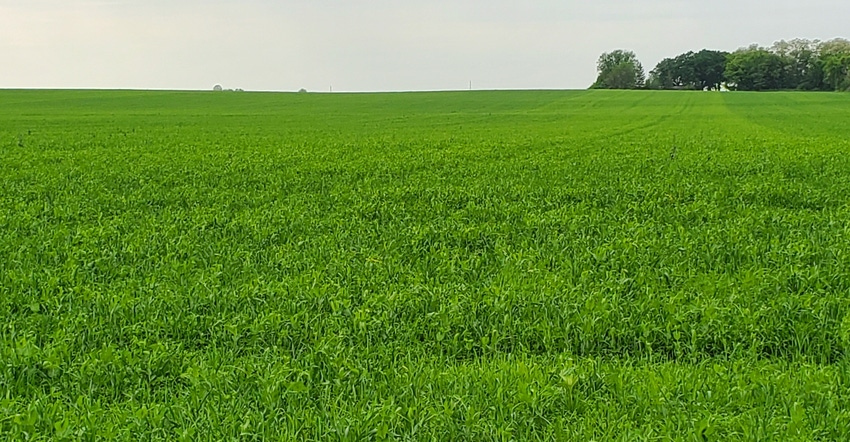June 9, 2022

While many “cocktail” alternative-forage mixes contain legumes, grass species dominate most mixtures. You cannot maximize the yield and quality of the grasses in these alternative-forage mixes without addressing their fertility needs. Current fertility recommendations are based on an established grass hayfield that equates to 130 pounds of nitrogen per acre.
During the 2021 growing season, we established field trials to determine how accurate these recommendations are. Three plots were established at Seven Oaks Dairy in Calumet County, Wis., at a field site with Manawa silt loam (MbA) and at Opportunity Acres in Oconto County, Wis., at a field site with Solona-Ossineke Complex. Plots were planted on April 24, 2021, at the Seven Oaks Dairy site and May 7, 2021, at the Opportunity Acres site.
Seven total N fertilizer rates — 0, 30, 60, 90, 120, 150 and 180 pounds per acre — were applied to four replications at each location using a randomized complete-block design. Nitrogen applications were made after first, second and third cuttings. Phosphorus and potassium were applied according to University of Wisconsin-Madison recommendations based on soil test results. Sulfur was applied at all locations at a rate of 17 pounds per acre at planting.
The cocktail mix included the following components:
26.27% Firkin Italian ryegrass
21.34% Max Italian ryegrass
21.34% Hunter Italian ryegrass
6.45% Winterking hairy vetch
6.45% medium red clover
6.45% Healy berseem clover
10.2% coating material
The Italian ryegrass blend included the following varieties:
29.55% Meroa Italian ryegrass
29.55% Firkin Italian ryegrass
39.4% Hunter Italian ryegrass
Seeding rates were 25 pounds per acre. Four cuttings were harvested from each plot site from July to November. The second through fourth cuttings are analyzed in the data below, as the first N application occurred after first cutting.

As illustrated in these charts, the left axis measures cumulative dry matter (DM) yield in tons per acre for the second through fourth cuttings, while the right axis measures milk production per acre — DM yield times milk per ton equals milk production per acre (MPA). The Italian ryegrass produced slightly more DM yield than the cocktail forage mix at the Seven Oaks Dairy site.
The economic optimum nitrogen rate indicates that N applications above this level do not provide an economic return, as yield begins to plateau or diminish as more fertilizer is applied. The EONR for both DM yield and MPA are identified for each location and crop. We were not able to identify the EONR for the Opportunity Acres site, as yield did not plateau; thus, the EONR was set at the highest rate applied of 180 pounds of N per acre.
Environmental considerations
Water quality affects everyone in Wisconsin. Agriculture has been and must continue to be vigilant in protecting our natural resources, now and for future generations. While phosphorus is our biggest nutrient concern in surface water, nitrates are our most significant concern for fresh groundwater aquifers. As a part of this research effort, we measured the soil nitrate levels at the sites we were evaluating before and after the project’s first year of completion.
As illustrated in the chart below, the dotted line marking 50 pounds of nitrogen per acre is what we consider to be the “background” level for the preplant nitrate test for corn — that is, any amount of N over 50 pounds per acre should be considered an N credit. The profile soil nitrate levels in the spring were high. We had the following N credits:
Seven Oaks Italian ryegrass site. 80 pounds per acre (130 minus 50 pounds N per acre)
Seven Oaks cocktail mix site. 45 pounds per acre credit (95 minus 50 pounds N per acre
Opportunity Acres cocktail mix site. 108 pounds per acre (158 minus 50 pounds N per acre)
These results indicate an overapplication of nitrogen and/or dry weather the previous growing season and over winter.

After the fourth cutting was harvested, we observed soil nitrate levels less than or near the background levels. At Seven Oaks, there was no significant difference in post fourth-cut soil profile nitrate levels among the zero, 90 and 180 pounds of N per acre rates for either Italian ryegrass or the cocktail mix. At Opportunity Acres, post fourth-cut soil profile nitrate levels at the 180-pound rate were significantly lower than the other two N rates sampled, but this difference is likely of minimal practical significance.
Conclusions from the first-year data collected as a part of this Midwest Forage Association-sponsored project:
N fertilization had very little impact on forage quality when measured as milk per ton.
DM yield drives MPA.
EONR for MPA was similar to EONR for DM yield
EONR was greater than current recommendations of 130 pounds of nitrogen per acre.
When N fertilizer is applied at rates near or less than the EONR, soil nitrate remaining in the profile after harvest is at about background levels.
Jarek is the Extension crops and soils agent in Outagamie County, Wis.
About the Author(s)
You May Also Like




